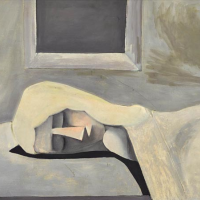47. CHARLES BLACKMAN

In this elusive portrayal of his sleeping wife and muse, Charles Blackman masks the personal in the universal. With hindsight he was also signalling the end of his schoolgirl series (that was essentially a projection of himself) in favour of a more individual human experience in line with his reading of literature, especially Dostoevsky (1821-1881). Indeed, Barbara Dreaming marks the transition from real life suburban environments and adolescent emotions - of guilt, fear, sexuality and the like - towards a subtler exploration of the mystery of femininity and the inner life and beings of his friends, people he knew well, such as Georges Mora (1913-1992) and Jack McKinney (1891-1966).
This new pictorial idea overlapped with the last burst of solitary seated or lying older schoolgirls, such as Prone Figure 1953 (Heide Museum and Art Gallery, Melbourne), Floating Schoolgirl 1954 (National Gallery of Australia, Canberra) and Girl with Blue Bows 1954 (private collection). Each of these works shared a similar motif: a black angle of shadow bearing no logical connection to the figure. Likewise in Barbara Dreaming this surreal motif of Barbaras shadow edge assumes a vital role: for its curved corner, that pushes her rounded shoulder across to the bump in her hair, directs our attention towards the illusory presence of an angel in the upper right.
Whereas the uniformed schoolgirls were deliberately anonymous, and very often faceless, here the personal details of Barbaras identity are created with a certain amount of precision; and the real life suburban settings have become intimate interior spaces. Her features are clarified in light and shade and simple planes; their contours are delineated with grainy dots of tone; her jutting nose with its biting lip extension points to the smooth curve of her bare shoulder, and her serene face is capped by a veil of yellowish hair whose curled ends lift the edge of the pale blanket.
As in the late schoolgirls, the black shadow under her calm face has no rule; it takes no account of the prominence of her nose and finds its own edge instead. And this hard edge acts as a foil for the soft brush of pink light on her pale face. Poised below a closed grey window and roughly brushed frame, her pose evokes a sense of simplicity and humility.
The delicate interaction in this painting of dreams, shadows and prescient shapes heralds the future beginning of the Alice in Wonderland series. One is reminded for instance of the white tablecloth with pink reflection in The White Tablecloth 1956; or the cloudy shadow and hovering images in The Bouquet 1956.
The rapid evolution of Blackmans pictorial ideas was clearly enriched by Barbaras knowledge of psychology, especially her feeling for Carl Jung (1875-1961), and by what Blackman has himself described as Barbaras psychic ability to reach out. In the same interview (with ABC reporter Robert Peach) he said My sort of painting issparked off by what I feel about something perhaps in a book. And I suppose its got to do with the fact that Barbara and I have been related pretty successfully as people, because I go into her world to a degree. Her declining eyesight meant that he was reading to her at great length and their shared emotion was often intense.
Blackman was to come back to the theme of apparitions in interiors in London where he lived in the early sixties after winning the Helena Rubenstein Travelling Scholarship. The theme resonated, as he remembered, with his supernatural experiences in London apartments, with hearing people living above and below. In The Anteroom 1963, which is perhaps the most ethereal of these later variations, there is a similar glimpse of an angel behind the chair. In that same year, almost ten years after the present prescient painting, he collaborated with Al Alvarez (1921-) on a poem and drawing exchange which was later published as Apparition.
Felicity St John Moore